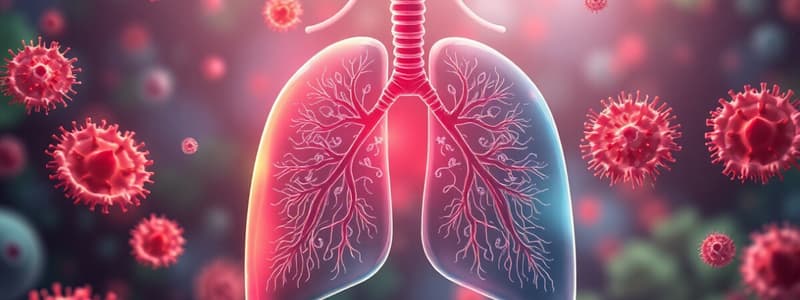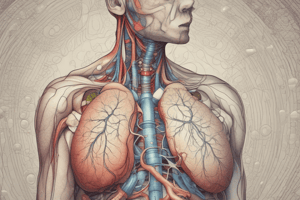Podcast
Questions and Answers
What is the primary role of normal flora in the respiratory system?
What is the primary role of normal flora in the respiratory system?
- They help prevent colonization by pathogenic organisms. (correct)
- They directly attack and destroy pathogens.
- They produce toxins that harm pathogens.
- They enhance the specificity of pathogen adhesion.
Which of the following is NOT a barrier of the respiratory tract to infection?
Which of the following is NOT a barrier of the respiratory tract to infection?
- Normal biota
- Symbiotic bacteria in the gut (correct)
- Secretory immunoglobulin
- Phagocytic inflammatory cells
What is a key characteristic of pathogens like Legionella?
What is a key characteristic of pathogens like Legionella?
- They can infect multiple systems in the body.
- They specifically infect the lungs. (correct)
- They are only found in the gastrointestinal tract.
- They have a high level of virulence factors.
What is the main function of adhesins in microbial pathogens?
What is the main function of adhesins in microbial pathogens?
How do certain pathogens evade host defenses effectively?
How do certain pathogens evade host defenses effectively?
What process does tuberculosis use to survive within host cells?
What process does tuberculosis use to survive within host cells?
What role do bacteriocins play in the respiratory tract?
What role do bacteriocins play in the respiratory tract?
Which method is appropriate for collecting a throat sample?
Which method is appropriate for collecting a throat sample?
Which of the following pathogens is commonly associated with middle ear infections in addition to respiratory issues?
Which of the following pathogens is commonly associated with middle ear infections in addition to respiratory issues?
During nasal swab collection, what is the recommended insertion depth?
During nasal swab collection, what is the recommended insertion depth?
What type of immune response is primarily engaged when pathogens are recognized for the first time?
What type of immune response is primarily engaged when pathogens are recognized for the first time?
What type of sample is essential for detecting Mycobacterium through AFB staining?
What type of sample is essential for detecting Mycobacterium through AFB staining?
What type of reaction indicates complete hemolysis on blood agar?
What type of reaction indicates complete hemolysis on blood agar?
Which organism is identified by beta hemolysis on blood agar?
Which organism is identified by beta hemolysis on blood agar?
What should be avoided while collecting sputum to minimize contamination?
What should be avoided while collecting sputum to minimize contamination?
Which reaction on blood agar shows no hemolytic activity?
Which reaction on blood agar shows no hemolytic activity?
What is the primary causative agent of laryngitis?
What is the primary causative agent of laryngitis?
What condition is characterized by inflammation of the cartilage covering the windpipe?
What condition is characterized by inflammation of the cartilage covering the windpipe?
Which organism is commonly associated with otitis media?
Which organism is commonly associated with otitis media?
Which of the following microorganisms is known to be catalase negative?
Which of the following microorganisms is known to be catalase negative?
What is the primary clinical significance of the polysaccharide capsule of Streptococcus pneumoniae?
What is the primary clinical significance of the polysaccharide capsule of Streptococcus pneumoniae?
Which of the following conditions is most commonly associated with Streptococcus pneumoniae?
Which of the following conditions is most commonly associated with Streptococcus pneumoniae?
What is the shape and arrangement of Streptococcus pneumoniae when observed under a microscope?
What is the shape and arrangement of Streptococcus pneumoniae when observed under a microscope?
Which of the following is a less common but dangerous complication related to infections in the upper respiratory tract?
Which of the following is a less common but dangerous complication related to infections in the upper respiratory tract?
What is the primary method of combating the effects of diphtheria toxin?
What is the primary method of combating the effects of diphtheria toxin?
What are the potential local effects of a Corynebacterium diphtheriae infection?
What are the potential local effects of a Corynebacterium diphtheriae infection?
Which of the following statements about Corynebacterium diphtheriae is correct?
Which of the following statements about Corynebacterium diphtheriae is correct?
Which virus type has been associated with several hundred serotypes and mainly causes upper respiratory infections?
Which virus type has been associated with several hundred serotypes and mainly causes upper respiratory infections?
What characteristic distinguishes parainfluenza viruses from influenza viruses?
What characteristic distinguishes parainfluenza viruses from influenza viruses?
Which of the following is NOT a common symptom of diphtheria?
Which of the following is NOT a common symptom of diphtheria?
What type of virus is primarily responsible for parainfluenza infections?
What type of virus is primarily responsible for parainfluenza infections?
What is the incubation period for diphtheria?
What is the incubation period for diphtheria?
What is the most common complication associated with pertussis?
What is the most common complication associated with pertussis?
Which organism is responsible for inhalation anthrax?
Which organism is responsible for inhalation anthrax?
How is Legionella pneumophila primarily transmitted to humans?
How is Legionella pneumophila primarily transmitted to humans?
What initial symptoms are associated with pulmonary anthrax?
What initial symptoms are associated with pulmonary anthrax?
What is the incubation period for pertussis?
What is the incubation period for pertussis?
Which antibiotic is noted as being more effective against Legionella pneumophila than penicillin?
Which antibiotic is noted as being more effective against Legionella pneumophila than penicillin?
What characteristic of Bacillus anthracis aids its survival in human tissues?
What characteristic of Bacillus anthracis aids its survival in human tissues?
What percentage of acute respiratory tract infections in the US are believed to be of viral origin?
What percentage of acute respiratory tract infections in the US are believed to be of viral origin?
Flashcards are hidden until you start studying
Study Notes
The Respiratory System
- The respiratory system is the most accessible system in the body.
- The body has a variety of host defense mechanisms to protect against infection, including innate and adaptive immune responses.
- The respiratory tract has several barriers to infection: nasal hair, mucociliary cells that line mucosal surfaces, coughing, secretory immunoglobulin, normal biota (normal flora), phagocytic inflammatory cells, and defensins.
### Role of Normal Flora
- Normal flora in the nasopharynx and oropharynx prevent colonization by pathogenic organisms by competing for nutrients and receptor sites on host cells.
- Normal flora also produce bacteriocins, bacterial products that are toxic to potential pathogens, to stimulate cross-protective immune factors.
Pathogens of the Respiratory System
- Some pathogens are restricted to specific sites, such as Legionella, which only infects the lungs.
- Other pathogens cause infection in multiple areas, such as Streptococcus, which can cause middle ear infections, sinusitis, and pneumonia.
- Pathogens use virulence factors such as adherence, toxins and evading host defences to cause infection.
Virulence Factors of Pathogens in RTI
- Adherence is a primary step in the infection process, mediated by adhesins or other microbial surface molecules or organelles.
- Specific bacterial adhesins interact with specific cellular receptors.
- Toxins can cause damage to the host's cells and tissues.
- Some pathogens evade the host's defenses by expressing polysaccharide capsules to prevent phagocytosis by host leukocytes.
Bacterial Infections of the Upper Respiratory Tract
- Upper respiratory tract infections include laryngitis, epiglottitis, otitis media, mastoiditis, sinusitis, pharyngitis, scarlet fever, and diphtheria.
Laryngitis & Epiglottitis
- Laryngitis is swelling and irritation of the larynx and is usually associated with hoarseness or loss of voice.
- Epiglottitis is inflammation of the cartilage that covers the trachea.
Otitis Media, Mastoiditis, and Sinusitis
- Otitis media is a general term for infection or inflammation of the ear.
- Mastoiditis is inflammation of the mastoid cavity, which is located near the nervous system and large blood vessels.
- Sinusitis is inflammation of the sinuses and nasal passages.
Streptococcus Pneumoniae
- Streptococcus pneumoniae is a gram-positive coccus that is 0.5 to 1.2 μm in diameter.
- It is often oval or lancet shaped and arranged in pairs and short chains.
- Older cells decolorize readily and appear gram-negative.
- It is alpha hemolytic on blood agar and catalase negative.
- It is covered with a complex polysaccharide capsule.
- This polysaccharide capsule is used for the serologic classification of strains, with 90 serotypes currently recognized.
Diphtheria
- Diphtheria is caused by Corynebacterium diphtheriae, a small gram-positive bacillus.
- Diphtheria infection is rare when vaccination is in place.
- Diphtheria toxin neutralization is the most important treatment.
- Corynebacterium diphtheriae is sensitive to many antibiotics.
Diphtheria: Pathogenesis
- Corynebacterium diphtheriae is poorly invasive.
- The effects of infection are due to the exotoxin produced.
- Local effects include epithelial cell necrosis and inflammation.
- A pseudomembrane is composed of a mixture of fibrin, leukocytes, and cell debris.
- The incubation period for diphtheria is two to four days.
- Diphtheria usually presents as pharyngitis or tonsillitis with fever, sore throat, and malaise.
Viral Infections of the Upper Respiratory Tract
- Viral infections of the upper respiratory tract are common, with rhinovirus and parainfluenza viruses being the most prevalent.
- Rhinoviruses are small, non-enveloped, single-stranded RNA viruses.
- Parainfluenza viruses are single-stranded enveloped RNA viruses.
Pertussis
- Pertussis is caused by Bordetella pertussis, a small, aerobic, gram-negative coccobacillus.
- Pertussis does not invade the cells of the respiratory tract or deeper tissues.
- Pertussis has an incubation period of 7 to 10 days.
- Pertussis infection has three stages: catarrhal, paroxysmal, and convalescent.
Inhalation Anthrax
- Inhalation anthrax is a serious infection caused by Bacillus anthracis.
- The causative agent is Bacillus anthracis, a gram-positive rod that is spore-forming.
- Inhalation anthrax is a fulminate pneumonia.
Inhalation Anthrax: Pathogenesis
- The spores of Bacillus anthracis germinate in human tissues.
- Pathogenesis results from the powerful exotoxin produced.
- Symptoms of pulmonary anthrax include malaise, mild fever, nonproductive cough, progressive respiratory distress, and cyanosis.
Legionella Pneumonia (Legionnaires' Disease)
- Legionella pneumonia is caused by Legionella pneumophila.
- Legionella pneumophila is a gram-negative rod that cannot be stained or grown using normal techniques.
- It is ubiquitous in fresh water.
- Transmission occurs through aerosolized water.
Viral Infections of the Lower Respiratory Tract
- Viral infections of the lower respiratory tract are the most common causes of acute respiratory tract infections.
Studying That Suits You
Use AI to generate personalized quizzes and flashcards to suit your learning preferences.




